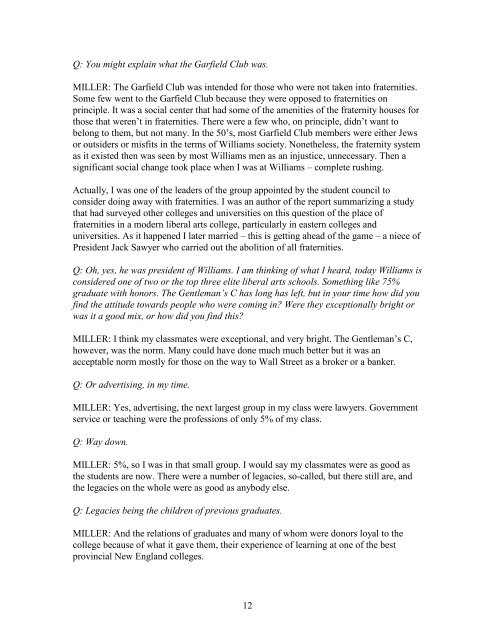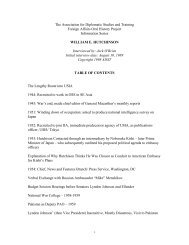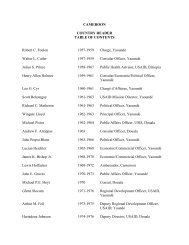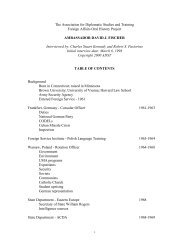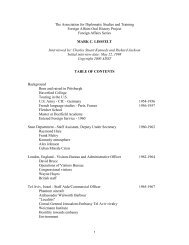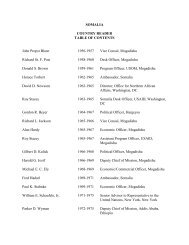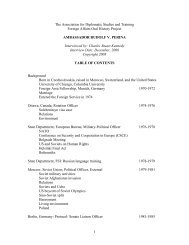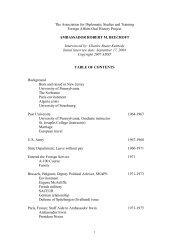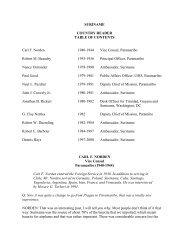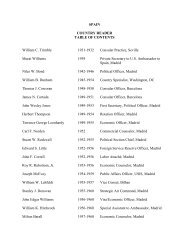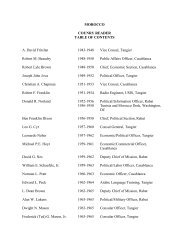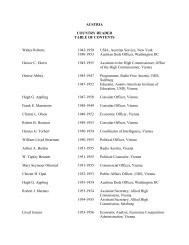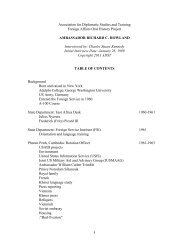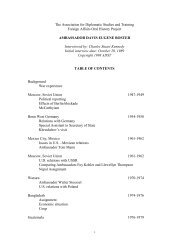1 The Association for Diplomatic Studies and Training Foreign ...
1 The Association for Diplomatic Studies and Training Foreign ...
1 The Association for Diplomatic Studies and Training Foreign ...
You also want an ePaper? Increase the reach of your titles
YUMPU automatically turns print PDFs into web optimized ePapers that Google loves.
Q: You might explain what the Garfield Club was.<br />
MILLER: <strong>The</strong> Garfield Club was intended <strong>for</strong> those who were not taken into fraternities.<br />
Some few went to the Garfield Club because they were opposed to fraternities on<br />
principle. It was a social center that had some of the amenities of the fraternity houses <strong>for</strong><br />
those that weren’t in fraternities. <strong>The</strong>re were a few who, on principle, didn’t want to<br />
belong to them, but not many. In the 50’s, most Garfield Club members were either Jews<br />
or outsiders or misfits in the terms of Williams society. Nonetheless, the fraternity system<br />
as it existed then was seen by most Williams men as an injustice, unnecessary. <strong>The</strong>n a<br />
significant social change took place when I was at Williams – complete rushing.<br />
Actually, I was one of the leaders of the group appointed by the student council to<br />
consider doing away with fraternities. I was an author of the report summarizing a study<br />
that had surveyed other colleges <strong>and</strong> universities on this question of the place of<br />
fraternities in a modern liberal arts college, particularly in eastern colleges <strong>and</strong><br />
universities. As it happened I later married – this is getting ahead of the game – a niece of<br />
President Jack Sawyer who carried out the abolition of all fraternities.<br />
Q: Oh, yes, he was president of Williams. I am thinking of what I heard, today Williams is<br />
considered one of two or the top three elite liberal arts schools. Something like 75%<br />
graduate with honors. <strong>The</strong> Gentleman’s C has long has left, but in your time how did you<br />
find the attitude towards people who were coming in? Were they exceptionally bright or<br />
was it a good mix, or how did you find this?<br />
MILLER: I think my classmates were exceptional, <strong>and</strong> very bright. <strong>The</strong> Gentleman’s C,<br />
however, was the norm. Many could have done much much better but it was an<br />
acceptable norm mostly <strong>for</strong> those on the way to Wall Street as a broker or a banker.<br />
Q: Or advertising, in my time.<br />
MILLER: Yes, advertising, the next largest group in my class were lawyers. Government<br />
service or teaching were the professions of only 5% of my class.<br />
Q: Way down.<br />
MILLER: 5%, so I was in that small group. I would say my classmates were as good as<br />
the students are now. <strong>The</strong>re were a number of legacies, so-called, but there still are, <strong>and</strong><br />
the legacies on the whole were as good as anybody else.<br />
Q: Legacies being the children of previous graduates.<br />
MILLER: And the relations of graduates <strong>and</strong> many of whom were donors loyal to the<br />
college because of what it gave them, their experience of learning at one of the best<br />
provincial New Engl<strong>and</strong> colleges.<br />
12


